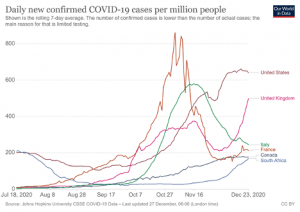Do Leaders Need to Change Their Plans to Address the New COVID-19 Strains?

Leadership
February 11, 2021
Gleb Tsipursky
CEO of Disaster Avoidance Experts
Topics
2021 plan, contingency planning, crisis planning, leaders, Leadership, strategic planning, work from homeShould leaders pivot their plans due to the possible impact of the new COVID strains - coming from the UK, South Africa, and elsewhere, and discovered across the US - on their businesses?
The authorities, various experts, as well as media have put the spotlight on concerns over vaccine effectiveness and said the strains are likely not going to escape the vaccine. They thus assert there's no need to ring the alarm.
Yet another element of these brand-new strains should make you much more ready to change your plans: they're a lot more infectious. However, the possible impact of their infectiousness has received not nearly enough attention.
Such complacency reflects our sleepwalking in the pandemic's beginning, in spite of direct advance warning from myself as well as other experts, causing us to be unable to plan and adapt successfully to this situation.
Are the New Strains Truly Much More Contagious?
Researchers believe the UK strain to be anywhere from 56% to 70% more contagious, and the South African strain to be more infectious than that. Compare new daily COVID cases per million people recently in the UK, South Africa, United States, Canada, Italy, and France.
Image courtesy of Our World In Data
There are only two countries with major spikes in recent weeks: the UK and South Africa. The UK's cases doubled within 2 weeks from 240 on December 10 to 506 on December 24; South Africa's figures in a similar way saw about the same increase in that timeframe from 86 to 182. Given no substantive policy changes or various other sound explanations, the new strains of the virus are most probably to blame.
Why We Overlook Slow-Moving Train Wrecks
Our minds aren't well adjusted to these seemingly-abstract numbers due to mental blindspots that behavioral scientists like myself term cognitive biases.
One example: we suffer from the propensity to focus on the short-term view. Called hyperbolic discounting, this cognitive bias leads us to take too lightly the eventual effects of obvious trends, such as an extra contagious strain of COVID-19.
The normalcy bias, unfortunately, prompts us to feel that things will typically keep going as they normally have. As a result, we undervalue drastically both the possibility of a significant disruption happening and also the effect of one if it does occur, such as novel strains.
When we establish strategies, we feel that the future will certainly follow our strategy. That mental blindspot, called the planning fallacy, endangers our capability to prepare successfully for, as well as pivot our plans quickly when dealing with new threats, such as the novel COVID strains.
The Implications of Much Greater Infectiousness
The novel strains most likely showed up right here by mid-November, with hundreds of possible cases by early January. Based on the timeline in the UK & South Africa, these strains will be predominant in the US by March or April.
The United States has sustained over 200,000 new COVID cases daily from December 10 to December 24 and topped 250,000 recently. Just think of what might happen when the novel strains overtake the old ones, at some point doubling every two weeks.
Our healthcare system is already dealing with an enormous load of cases in a lot of states. How will it handle a doubling of cases every two weeks? The surge will flood our medical systems, create significant supply interruptions, and hit sectors like travel and hospitality.
Might vaccines help? Not until the summertime, as a result of the slow rollout.
What about government lockdowns? Not likely. The severe politicization, extensive demonstrations, as well as serious financial discomfort from lockdowns make politicians very hesitant to enforce the sort of extreme lockdown necessary to fight these novel strains. Even if some do, mass public disobedience will certainly make lockdowns inefficient.
What Can You Do?
Prepare your team:
- Communicate to them regarding the novel strains: urge them to take actions to safeguard their households
- Highly encourage your employees to avail themselves of any psychological health resources you offer to get ready for the trauma of mass deaths
- Coordinate with your HR on how to make up for the much greater likely caseload of COVID in your team as well as burnout; ensure cross-training for important roles
- Act quickly to move your team to work from home
- Review your most current business continuity plan to prepare for the Spring and Summer
- Prepare for significant interruptions to your supply chains and vendors
Conclusion
While this evidence may feel unreal, keep in mind that's simply our cognitive biases pushing us to feel like that, just like they did early in the pandemic. This time, be on guard, and don’t ignore this warning.






